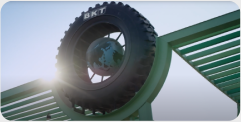There are two main types of dump truck for off road hauling: rigid and articulated. While these trucks may look similar to the naked eye, there are key differences which lead them to be suited to different tasks. So, rigid vs. articulated: what’s the difference?
“Slow and steady wins the race” – have you ever heard that saying? Well, that’s the dump truck in a nutshell. What the dump truck lacks in speed, it more than compensates with strength and sturdiness. These sizable trucks are used for transporting – and, as the name suggests, ‘dumping’ – construction or mining materials. As we’re sure you’ve seen, a dump truck is a standard truck complete with a hinged “open-box bed”.
There are two main types of dump truck for off road hauling: rigid and articulated. While these trucks may look similar to the naked eye, there are key differences which lead them to be suited to different tasks. So, rigid vs. articulated: what’s the difference?
What Are Rigid Dump Trucks?
In the red corner, we have the rigid dumpers. Now, rigid dump trucks are designed to transport large, rocky materials across rocky terrain.
The key difference between the appearance of the rigid and articulated dump trucks lies with the frame; rigid dump trucks consist of a cab and dump body that both sit upon one fixed chassis – a chassis being the supportive frame of any vehicle.
So, now that we have established how the rigid dump truck ‘dumps’ materials, how is it steered? Well, the truck has a traditional steering design, with a single front steering axle, and one rear axle. This combination allows this sturdy truck to handle maximum weight.
What Are Articulated Dump Trucks?
And in the blue corner, let’s meet the articulated dump truck. One of the other prime differences between the two is their suitability to different types of terrain; in contrast to rigid dumpers, articulated dump trucks are more flexible and can be used in narrower, twisted and steeper roads, in addition to extreme weather conditions. However, this lighter vehicle lacks the strength and longevity of its opponent.
In terms of appearance, articulated dump trucks namely have a point of ‘articulation’ behind the cab – where it is attached to the vehicle’s tipping body. This makes the truck easy to manoeuvre, with its increased range of motion and flexibility to pivot, in comparison to rigid dump trucks, which are, as their name would suggest, more rigid by nature!
Which Truck is Right For The Job?
Both rigid and articulated dump trucks are used across both the construction and mining industries. It’s evident from our prior summaries that the rigid truck is more sizable and stable, while the articulated truck is a smaller, lighter, more versatile vehicle. Therefore, while these trucks are used across similar industries, they are typically used for different jobs.
So, without further ado, here are some factors to consider when choosing a truck for a specific project or task. Firstly, consider the size of the site you’re working on, and how far the vehicle would have to travel. As previously mentioned, rigid trucks thrive in long distances and large spaces, whereas articulated trucks perform better on smaller sites - as this is where they can showcase their manoeuvrability!
Secondly, we’ve mentioned the impacts of terrain a fair few times. Therefore, you should always carefully consider what type of terrain your truck would be travelling on. Rigid dump trucks can cope with rocky terrain - but to a more extreme extent, articulated dump trucks can handle almost anything you throw at them! Whatever the weather, and whatever is occurring underfoot (or should we say ‘underwheel’!), articulated dump trucks are your go to.
Bear in mind the size of the truck and its maximum capacity, also - how much material needs to be moved, for example? This will lead to you evaluating what specific job you need this truck for, which naturally factors in the aforementioned criteria. For example, articulated trucks are often used in small construction sites, underground mines, and in quarries with narrow and twisty roads. On the other hand, we’ve explored how rigid trucks are better suited to long haul journeys with flatter terrain, which results in them being predominantly used in surface mines or larger quarries, where large quantities of material are required to be transported, and the roads are flat and well maintained.
Why Choose BKT Tires?
We confidently claim that mining and construction are the toughest sectors on Earth. So, naturally, the requirements for equipment - and tires, of course - mirror this. At BKT, we pride ourselves on the high quality of our tires; our broad range of products are all designed fit to purpose, and our OTR tires are no exception. The EARTHMAX SR 46, for example, is specifically designed to carry heavy loads across severe rocky, abrasive and harsh mining environments - making it the perfect fit for rigid dump trucks. Alternatively, our EARTHMAX SR 41 is ideal for articulated dump trucks, with its all steel structure and special block pattern.
Browse our website to discover this tire, and more. We guarantee you’ll find the perfect fit for your articulated or rigid dumper truck, so that you can get cracking with that next big construction project - aboard the correct truck for the challenge!





